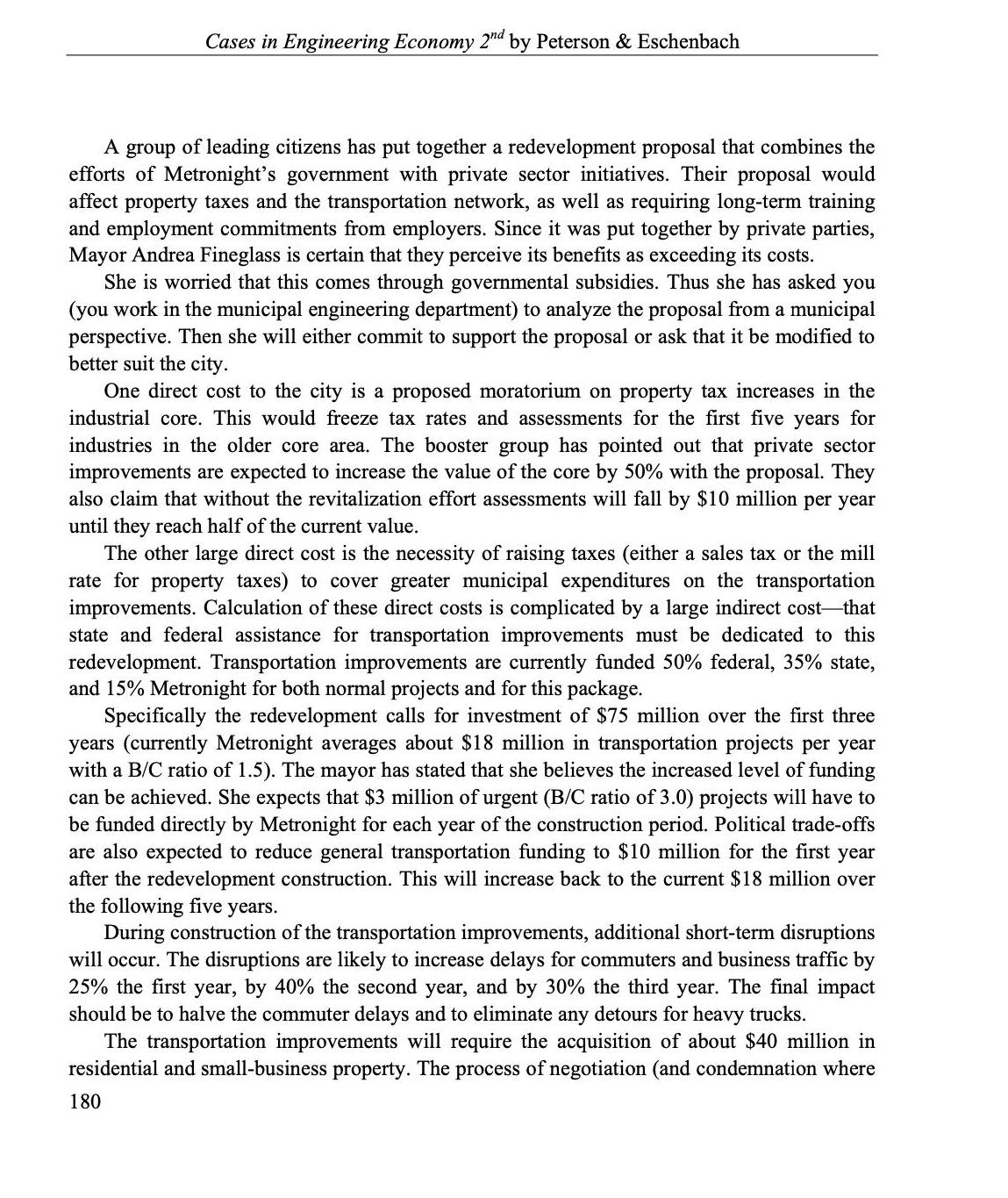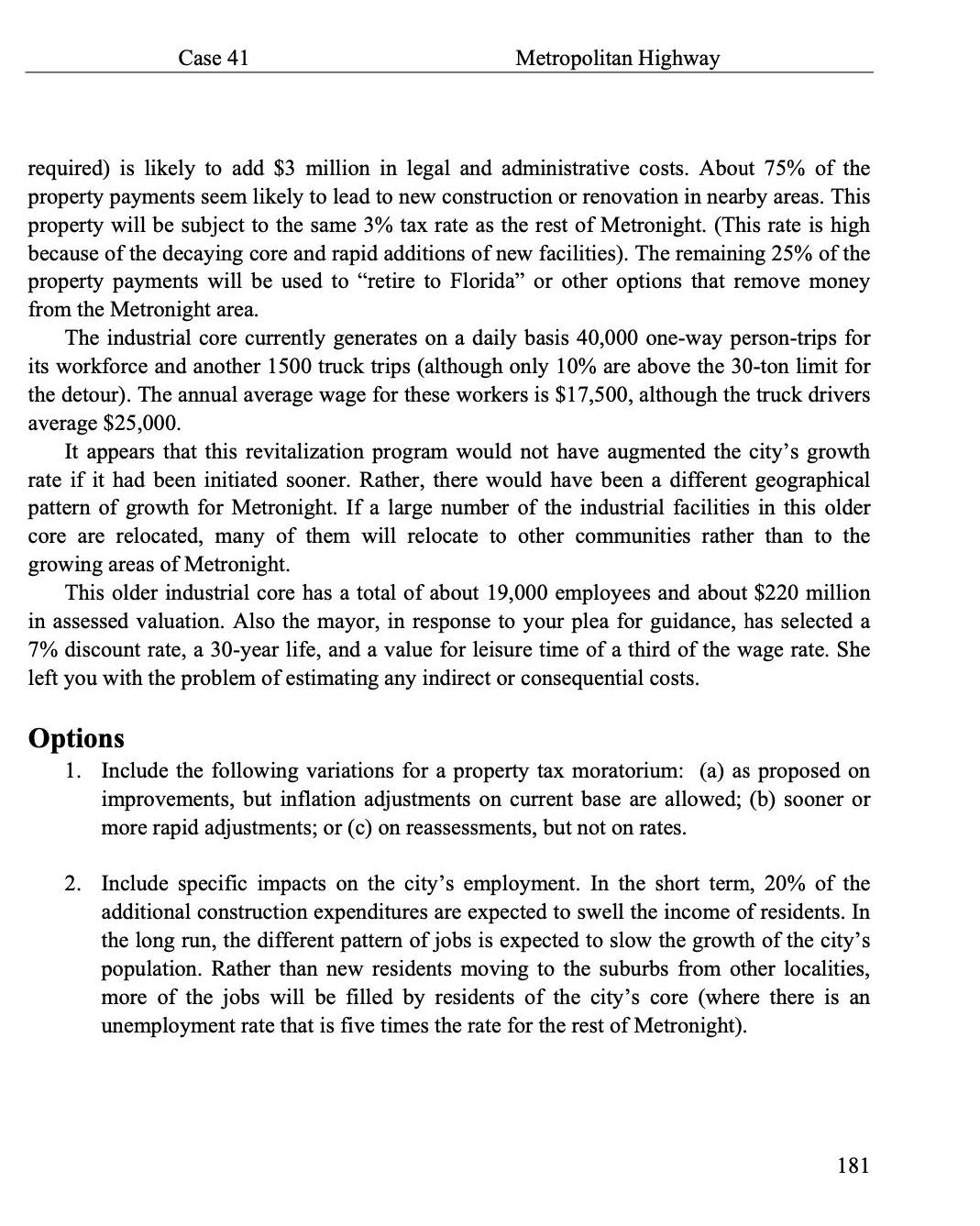Answered step by step
Verified Expert Solution
Question
1 Approved Answer
Metronight is the fastest growing city in the country's Moon Belt, with a growth rate of nearly 11% per year for the last decade.



Metronight is the fastest growing city in the country's "Moon Belt," with a growth rate of nearly 11% per year for the last decade. This growth has offered unprecedented economic opportunities both to long-time residents and to newcomers. It has also brought pollution problems, severe traffic congestion, and increased community tensions. These tensions have come from a more rapid pace of life and from an uneven distribution of the benefits and costs of growth over the communities that make up Metronight. In particular, suburbs, strip development, industrial parks, and shopping malls have grown rapidly. On the other hand, the older residential and industrial areas have not grown, but instead have decayed marginally. During the last year there has been an alarming increase in the unemployment rate within the central city. Even worse, one of the largest industrial plants (9000 employees) has announced that it will close, rather than renovate, its facility within the year unless the city significantly improves the transportation network. Because of the rapid growth, construction of expressways has consistently lagged behind the level of traffic demand. Commuters to the older industrial core from the newer residential areas face delays averaging about 45 minutes for both the morning and evening trips-in addition to the normal travel time between work and home. More importantly, the city's road system within its older core suffers from aging pavement and bridges. Already, larger tractor- trailer rigs (those over 30 tons) must detour around a weakened bridge that crosses the river that forms the eastern boundary of the older industrial core. This detour adds about 20 minutes to the average one-way trip (they are scheduled to avoid rush hour). Cases in Engineering Economy 2nd by Peterson & Eschenbach A group of leading citizens has put together a redevelopment proposal that combines the efforts of Metronight's government with private sector initiatives. Their proposal would affect property taxes and the transportation network, as well as requiring long-term training and employment commitments from employers. Since it was put together by private parties, Mayor Andrea Fineglass is certain that they perceive its benefits as exceeding its costs. She is worried that this comes through governmental subsidies. Thus she has asked you (you work in the municipal engineering department) to analyze the proposal from a municipal perspective. Then she will either commit to support the proposal or ask that it be modified to better suit the city. One direct cost to the city is a proposed moratorium on property tax increases in the industrial core. This would freeze tax rates and assessments for the first five years for industries in the older core area. The booster group has pointed out that private sector improvements are expected to increase the value of the core by 50% with the proposal. They also claim that without the revitalization effort assessments will fall by $10 million per year until they reach half of the current value. The other large direct cost is the necessity of raising taxes (either a sales tax or the mill rate for property taxes) to cover greater municipal expenditures on the transportation improvements. Calculation of these direct costs is complicated by a large indirect cost-that state and federal assistance for transportation improvements must be dedicated to this redevelopment. Transportation improvements are currently funded 50% federal, 35% state, and 15% Metronight for both normal projects and for this package. Specifically the redevelopment calls for investment of $75 million over the first three years (currently Metronight averages about $18 million in transportation projects per year with a B/C ratio of 1.5). The mayor has stated that she believes the increased level of funding can be achieved. She expects that $3 million of urgent (B/C ratio of 3.0) projects will have to be funded directly by Metronight for each year of the construction period. Political trade-offs are also expected to reduce general transportation funding to $10 million for the first year after the redevelopment construction. This will increase back to the current $18 million over the following five years. During construction of the transportation improvements, additional short-term disruptions will occur. The disruptions are likely to increase delays for commuters and business traffic by 25% the first year, by 40% the second year, and by 30% the third year. The final impact should be to halve the commuter delays and to eliminate any detours for heavy trucks. The transportation improvements will require the acquisition of about $40 million in residential and small-business property. The process of negotiation (and condemnation where 180 Case 41 Metropolitan Highway required) is likely to add $3 million in legal and administrative costs. About 75% of the property payments seem likely to lead to new construction or renovation in nearby areas. This property will be subject to the same 3% tax rate as the rest of Metronight. (This rate is high because of the decaying core and rapid additions of new facilities). The remaining 25% of the property payments will be used to "retire to Florida" or other options that remove money from the Metronight area. The industrial core currently generates on a daily basis 40,000 one-way person-trips for its workforce and another 1500 truck trips (although only 10% are above the 30-ton limit for the detour). The annual average wage for these workers is $17,500, although the truck drivers average $25,000. It appears that this revitalization program would not have augmented the city's growth rate if it had been initiated sooner. Rather, there would have been a different geographical pattern of growth for Metronight. If a large number of the industrial facilities in this older core are relocated, many of them will relocate to other communities rather than to the growing areas of Metronight. This older industrial core has a total of about 19,000 employees and about $220 million in assessed valuation. Also the mayor, in response to your plea for guidance, has selected a 7% discount rate, a 30-year life, and a value for leisure time of a third of the wage rate. She left you with the problem of estimating any indirect or consequential costs. Options 1. Include the following variations for a property tax moratorium: (a) as proposed on improvements, but inflation adjustments on current base are allowed; (b) sooner or more rapid adjustments; or (c) on reassessments, but not on rates. 2. Include specific impacts on the city's employment. In the short term, 20% of the additional construction expenditures are expected to swell the income of residents. In the long run, the different pattern of jobs is expected to slow the growth of the city's population. Rather than new residents moving to the suburbs from other localities, more of the jobs will be filled by residents of the city's core (where there is an unemployment rate that is five times the rate for the rest of Metronight). 181
Step by Step Solution
★★★★★
3.44 Rating (157 Votes )
There are 3 Steps involved in it
Step: 1
The city of Metronight is experiencing rapid growth but this has led to pollution problems severe traffic congestion and increased community tensions ...
Get Instant Access to Expert-Tailored Solutions
See step-by-step solutions with expert insights and AI powered tools for academic success
Step: 2

Step: 3

Ace Your Homework with AI
Get the answers you need in no time with our AI-driven, step-by-step assistance
Get Started


